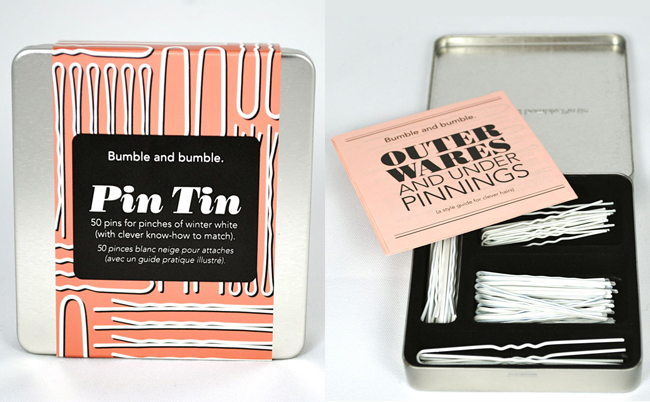I am a bobby pin novice. In fact, before the pin tin, I had only used Goody Spin Pins. I love the spin pins for the simplicity, but their construction limits you to pretty basic styles. I decided to broaden my horizons with the Bumble and Bumble Pin Tin, an adorable set of 50 custom-designed hair pins in winter white.
You can tell these are quality pins. After quite a bit of abuse, mine have retained their shape and strength. The silver tin comes with an assortment of pins, all designed for different functionality.
- 5 3″ hair pins for heavier updos (these are my favorite, probably due to my long hair)
- 10 2″ hair pins for tacking down chignons and twists (these work well for my tighter buns)
- 25 2.5″ bobby pins for a wavy side up or down for a neat hold
- 20 2″ bobby pins used for finishing
What’s the difference between the hair pin and bobby pin? So glad you asked. Hair pins have roots in China, Japan and Korea but the “bobby pin” came into wide use in the 1920’s with the new bobbed hair styles. A bobby pin is a double-pronged hair pin that slides into hair with the prongs open and then the flexible prongs close over the hair to hold it in place. A trademark on the term “bobby pin” was held for some decades by Bob Lépine Corporation but eventually became part of the common hairstyle vernacular. It wasn’t until the late 1990’s that it became fashionable for this pins to actually be a visible part of the hairstyle.
There are some tutorials on a slip of paper included in the pin tin. Frankly, I haven’t paid much attention to them. The key to exploring these new tools is some surf spray and a couple minutes playing in front of the mirror. I was surprised by how well the simple pins hold up my hair. My favorite so far is a haphazard pony pinned up into a messy bun. But the smaller hair pins are my go-to for a simple and neat low bun during a workout when I want to avoid that “pony-tail bend” effect.
